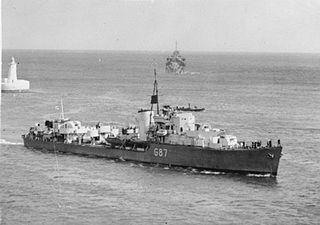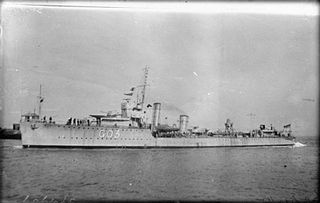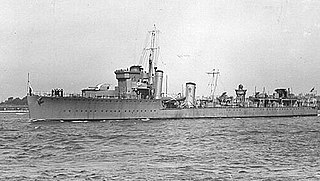Wartime career
Woolston was still under refit at Chatham on the outbreak of the Second World War. Around this time her pennant number was changed to L49, to match those used by escort destroyers. She spent October on post refit trials and then commissioned for service, joining the Nore Command in November to commence convoy defence duties in the English Channel and the North Sea. She continued these duties for the rest of 1939 and all of 1940. She was detached for a period in 1941 to cover Atlantic convoys as they passed through the Western Approaches. In February 1942 Woolston was reassigned to the Home Fleet and sailed to Scapa Flow. After a successful 'Warship Week' in March 1942 she was adopted by Congleton, Cheshire. In March she was one of a number of destroyers screening heavy fleet units covering the passage of the Arctic convoys PQ 12 and the returning PQ 8. Woolston then returned to the Nore Command and spent the rest of the year deploying in the North Sea. Woolston was part of the fleet that put to see in July 1942 in an attempt intercept the German battleship Tirpitz. [3]
She continued in these duties until May 1943, when she was assigned to cover military convoys passing through the Atlantic carrying troops and supplies for the allied invasion of Sicily. She sailed to the Clyde on 20 June and joined the outbound military convoy WS-31 on passage to Gibraltar. She and the other escorts were detached from the convoy on its arrival in Gibraltar on 26 June. Woolston then took passage to Bône in early July and was nominated to join the Eastern Support force in Escort Group V. She left Bône on 7 July as part of the military convoy KMF18 on passage to the beach head, and was detached on 9 July to refuel in Malta. She returned the next day to join the Escort Group in providing anti-aircraft defence of the anchorages off the beach head. On the successful completion of the landings Woolston returned to the Nore Command and spent the rest of 1943 on convoy defence duty in the North Sea. She remained at this task for the rest of the war.

HMS Lance was an L-class destroyer of the Royal Navy. She entered service during World War II, and had a short but eventful career, serving in Home waters and the Mediterranean Sea. She was damaged in two consecutive air attacks at Malta in 1942. She was towed back to Britain, declared a constructive total loss and was scrapped. She had been adopted by the civil community of Bexley and Welling, Kent in November 1941.

HMS Acheron was an A-class destroyer of the Royal Navy. She served during the Second World War in Home waters and off the Norwegian coast, before becoming an early war loss when she sank after hitting a mine off the Isle of Wight on 17 December 1940. The wreck site is designated under the Protection of Military Remains Act 1986.

HMS Codrington was one of nine A-class destroyers built for the Royal Navy during the 1920s. She was the flotilla leader for the class. During the Second World War she served in Home waters and off the Norwegian coast, before being bombed and sunk on 27 July 1940 whilst in dock at Dover.

HMS Arrow was an A-class destroyer of the Royal Navy. She served during the Second World War before being damaged while fighting a fire on an ammunition ship and written off in 1943.

HMS Opportune was an O-class destroyer of the Royal Navy. She was ordered from John I. Thornycroft & Company, Woolston on 3 September 1939 for the 1st Emergency Flotilla. She was commissioned on 14 August 1942. She was the second Royal Navy ship borne Opportune.

HMS Vortigern was a V-class destroyer of the Royal Navy. She served in both World Wars, and was sunk in 1942.

HMS Wren (D88/I88) was an Admiralty modified W class destroyer built for the Royal Navy. She was ordered in April 1918 from Yarrow Shipbuilders Limited under the 13th Order for Destroyers of the Emergency War Program of 1918–19. She was the third Royal Navy ship to carry the name, which was introduced in 1653.

HMS Whitley (L23), ex-Whitby, was a W-class destroyer of the British Royal Navy that saw service in the British campaign in the Baltic Sea against Bolshevik forces during the Russian Civil War and in the early months of World War II.

HMS Vivacious (D36) was a V-class destroyer of the British Royal Navy that saw service in World War I and World War II.

HMS Witch (D89) was a Modified W-class destroyer of the British Royal Navy that saw service in World War II.

HMS Wishart (D67) was a Modified W-class destroyer of the British Royal Navy that saw service in World War II. She spent most of her wartime career based at Gibraltar, engaged in convoy defence, but also served in various naval and military operations in the Mediterranean Sea.

The second HMS Vanity was a V-class destroyer of the British Royal Navy that saw service in World War I and World War II.

The second HMS Vega was a V-class destroyer of the British Royal Navy that saw service in World War I and World War II.
HMS Venetia (D53) was a V-class destroyer of the British Royal Navy that saw service in World War I and World War II.

HMS Versatile (D32) was an Admiralty V-class destroyer of the British Royal Navy that saw service in World War I, the Russian Civil War, and World War II.

The third HMS Windsor (D42) was a W-class destroyer of the British Royal Navy that saw service in the final months of World War I and in World War II.

HMS Viceroy (D91) was a W-class destroyer of the British Royal Navy that saw service in the final months of World War I and in World War II.

The fourth HMS Volunteer (D71), later I71, was a Modified W-class destroyer of the British Royal Navy that saw service in World War II.

The second HMS Wivern, was a Modified W-class destroyer of the British Royal Navy that saw service in World War II.

The eighth HMS Worcester, was a Modified W-class destroyer of the British Royal Navy that saw service in World War II. She later served as an accommodation ship as the second HMS Yeoman.
This page is based on this
Wikipedia article Text is available under the
CC BY-SA 4.0 license; additional terms may apply.
Images, videos and audio are available under their respective licenses.



















